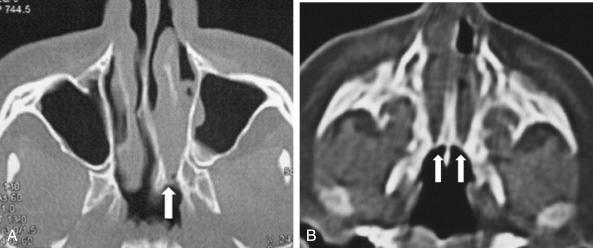Physical Address
304 North Cardinal St.
Dorchester Center, MA 02124
The opening of choanal atretic plates can be obtained by various techniques. Despite the substantial available published literature on the treatment modalities of choanal atresia, the optimum technique is not fully established. The choice many times depends on the surgeon’s preference. This chapter describes the cross-over flap technique, which can be employed in unilateral or bilateral choanal atresia.
Surgical endoscopic techniques incorporating mucosal flaps have been shown to minimize the healing reaction, reduce subsequent scarring, and may present less chance of restenosis. Knowledge of the anatomy, good visualization (0-degree endoscope), and utilization of very delicate surgical instruments facilitate an easier, faster, and safer procedure.
The choanal atretic plate may consist of a mucosal membrane or of bone covered by mucosa. The bony part is usually an extension of the medial pterygoid plate laterally and the vomer medially.
The nasal cavity itself is usually preserved anatomically.
Choana atresia patients are usually children, often newborns, who present with narrow and small nasal cavities. Every initial step should be directed to preventing unnecessary mucosal trauma and bleeding and to create more operating exposure. Preoperative mucosal topical decongestion is recommended. At least 5 minutes should elapse to allow the vasoconstrictive pledgets to decongest the mucosa.
To create more space to address the posterior part of the nasal cavity, cover the inferior turbinate with a piece of cotton and, with a delicate Freer elevator, gently move and outfracture it against the nasal lateral wall.
In order to facilitate tailoring while displacing the posterior septal mucosa and the mucosa of the posterior floor of the nasal cavity, infiltration elevation can be accomplished by using a saline solution.
Review in detail the axial and coronal computed tomography (CT) scans.
Identify the atretic plate verifying the presence or absence of bone. Not uncommonly, septal deviations coexist, further narrowing the operating field exposure ( Fig. 5.1 ).

Become a Clinical Tree membership for Full access and enjoy Unlimited articles
If you are a member. Log in here